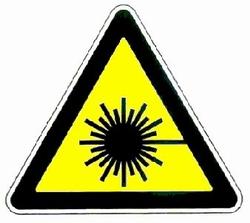No Fuel Needed -- Point Laser And Fly Away
 Ever since the dawn of powered
flight, it has been necessary for all aircraft to carry fuel
onboard - whether in the form of batteries, fuel, solar cells, or
even a human "engine" - in order to stay aloft.
Ever since the dawn of powered
flight, it has been necessary for all aircraft to carry fuel
onboard - whether in the form of batteries, fuel, solar cells, or
even a human "engine" - in order to stay aloft.
A team of researchers from NASA's Marshall Space Flight Center
in Huntsville (AL), NASA's Dryden Flight Research Center at Edwards
(CA), and the University of Alabama in Huntsville is trying to
change that.
They have now chalked up a major accomplishment... and a
"first." The team has developed and demonstrated a small-scale
aircraft that flies solely by means of propulsive power delivered
by an invisible, ground-based laser. The laser tracks the aircraft
in flight, directing its energy beam at specially designed
photovoltaic cells carried onboard to power the plane's
propeller.
"The craft could keep flying as long as the energy source, in
this case the laser beam, is uninterrupted," said Robert Burdine,
Marshall's laser project manager for the tests. "This is the first
time that we know of that a plane has been powered only by the
energy of laser light. It really is a groundbreaking development
for aviation."
 "We feel this really was a
tremendous success for the project," added David Bushman, project
manager for beamed power at Dryden. "We are always trying to
develop new technologies that will enable new capabilities in
flight, and we think this is a step in the right direction."
"We feel this really was a
tremendous success for the project," added David Bushman, project
manager for beamed power at Dryden. "We are always trying to
develop new technologies that will enable new capabilities in
flight, and we think this is a step in the right direction."
The plane, with its five-foot wingspan, weighs only 11 ounces
and is constructed from balsa wood and carbon fiber tubing covered
with Mylar film. Designed and built at NASA Dryden, the aircraft is
a one-of-a-kind, radio-controlled model airplane. A special panel
of photovoltaic cells, selected and tested by team participants at
the University of Alabama in Huntsville, is designed to efficiently
convert the energy from the laser wavelength into electricity to
power a small electric motor that spins the propeller.
The lightweight, low-speed plane was flown indoors at the
Marshall center to prevent wind and weather from affecting the test
flights.
After the craft was released from a launching platform inside
the building, the laser beam was aimed at the airplane's panels,
causing the propeller to spin and propel the craft around the
building, lap after lap. When the laser beam was turned off, the
airplane glided to a landing.

The team made a similar series of demonstration flights in 2002
at NASA Dryden, using a theatrical searchlight as a power source.
The recent flights at the Marshall center are the first known
demonstration of an aircraft flying totally powered by a
ground-based laser. The demonstration is a key step toward the
capability to beam power to a plane aloft. Without the need for
onboard fuel or batteries, such a plane could carry scientific or
communication equipment, for instance, and stay in flight
indefinitely. The concept offers potential commercial value to the
remote sensing and telecommunications industries, according to
Bushman.
"A telecommunications company could put transponders on an
airplane and fly it over a city," Bushman said. "The aircraft could
be used for everything from relaying cell phone calls to cable
television or Internet connections."
Laser power beaming is a promising technology for future
development of aircraft design and operations. The concept supports
NASA's mission-critical goals for the development of revolutionary
aerospace technologies.
 ANN's Daily Aero-Term (04.26.24): DETRESFA (Distress Phrase)
ANN's Daily Aero-Term (04.26.24): DETRESFA (Distress Phrase) ANN's Daily Aero-Linx (04.26.24)
ANN's Daily Aero-Linx (04.26.24) Airborne 04.22.24: Rotor X Worsens, Airport Fees 4 FNB?, USMC Drone Pilot
Airborne 04.22.24: Rotor X Worsens, Airport Fees 4 FNB?, USMC Drone Pilot Airborne 04.24.24: INTEGRAL E, Elixir USA, M700 RVSM
Airborne 04.24.24: INTEGRAL E, Elixir USA, M700 RVSM Airborne-NextGen 04.23.24: UAVOS UVH 170, magni650 Engine, World eVTOL Directory
Airborne-NextGen 04.23.24: UAVOS UVH 170, magni650 Engine, World eVTOL Directory





